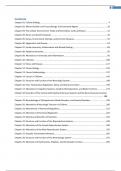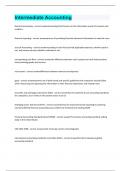sdfghjkhgfdsaASDFGHJHGFDSASDFGHFDFG 2
Contents
Chapter 01: Cellular Biology .......................................................................................................................... 4
Chapter 02: Altered Cellular and Tissue Biology: Environmental Agents ................................................... 18
Chapter 03: The Cellular Environment: Fluids and Electrolytes, Acids and Bases ...................................... 31
Chapter 04: Genes and Genetic Diseases ................................................................................................... 44
Chapter 05: Genes, Environment-Lifestyle, and Common Diseases ........................................................... 55
Chapter 06: Epigenetics and Disease .......................................................................................................... 63
Chapter 07: Innate Immunity: Inflammation and Wound Healing ............................................................. 68
Chapter 08: Adaptive Immunity .................................................................................................................. 83
Chapter 09: Alterations in Immunity and Inflammation ............................................................................. 95
Chapter 10: Infection ................................................................................................................................ 108
Chapter 11: Stress and Disease ................................................................................................................. 117
Chapter 12: Cancer Biology ....................................................................................................................... 124
Chapter 13: Cancer Epidemiology ............................................................................................................. 137
Chapter 14: Cancer in Children ................................................................................................................. 143
Chapter 15: Structure and Function of the Neurologic System ................................................................ 148
Chapter 16: Pain, Temperature Regulation, Sleep, and Sensory Function ............................................... 159
Chapter 17: Alterations in Cognitive Systems, Cerebral Hemodynamics, and Motor Function ............... 174
Chapter 18: Disorders of the Central and Peripheral Nervous Systems and the Neuromuscular Junction
.................................................................................................................................................................. 188
Chapter 19: Neurobiology of Schizophrenia, Mood Disorders, and Anxiety Disorders ............................ 199
Chapter 20: Alterations of Neurologic Function in Children ..................................................................... 206
Chapter 21: Mechanisms of Hormonal Regulation ................................................................................... 213
Chapter 22: Alterations of Hormonal Regulation ..................................................................................... 222
Chapter 23: Obesity and Disorders of Nutrition ....................................................................................... 234
Chapter 24: Structure and Function of the Reproductive Systems........................................................... 239
Chapter 25: Alterations of the Female Reproductive System................................................................... 249
Chapter 26: Alterations of the Male Reproductive System ...................................................................... 259
Chapter 27: Sexually Transmitted Infections ............................................................................................ 265
Chapter 28: Structure and Function of the Hematologic System ............................................................. 273
Chapter 29: Alterations of Erythrocytes, Platelets, and Hemostatic Function ......................................... 283
SDFGHJKLKJHGDFGHJKLQWERTYUIOPOZXCVBNMXCVBNBVCVBNBB
, sdfghjkhgfdsaASDFGHJHGFDSASDFGHFDFG 3
Chapter 30: Alterations of Leukocyte and Lymphoid Function ................................................................ 293
Chapter 31: Alterations of Hematologic Function in Children .................................................................. 300
Chapter 32: Structure and Function of the Cardiovascular and Lymphatic Systems ................................ 311
Chapter 33: Alterations of Cardiovascular Function ................................................................................. 324
Chapter 34: Alterations of Cardiovascular Function in Children ............................................................... 338
Chapter 35: Structure and Function of the Pulmonary System ................................................................ 346
Chapter 36: Alterations of Pulmonary Function ....................................................................................... 356
Chapter 37: Alterations of Pulmonary Function in Children ..................................................................... 373
Chapter 38: Structure and Function of the Renal and Urologic Systems .................................................. 381
Chapter 39: Alterations of Renal and Urinary Tract Function ................................................................... 391
Chapter 40: Alterations of Renal and Urinary Tract Function in Children ................................................ 401
Chapter 41: Structure and Function of the Digestive System ................................................................... 409
Chapter 42: Alterations of Digestive Function .......................................................................................... 421
Chapter 43: Alterations of Digestive Function in Children........................................................................ 432
Chapter 44: Structure and Function of the Musculoskeletal System ....................................................... 441
Chapter 45: Alterations of Musculoskeletal Function............................................................................... 453
Chapter 46: Alterations of Musculoskeletal Function in Children ............................................................ 466
Chapter 47: Structure, Function, and Disorders of the Integument ......................................................... 475
Chapter 48: Alterations of the Integument in Children ............................................................................ 486
Chapter 49: Shock, Multiple Organ Dysfunction Syndrome, and Burns in Adults .................................... 494
Chapter 50: Shock, Multiple Organ Dysfunction Syndrome, and Burns in Children ................................. 502
SDFGHJKLKJHGDFGHJKLQWERTYUIOPOZXCVBNMXCVBNBVCVBNBB
, Test Bank - Pathophysiology: The Biologic Basis for Disease in Adults and Children (8th) 4
Chapter 01: Cellular Biology
MULTIPLE CHOICE
1. Which statement best describes the cellular function of metabolic absorption?
a. Cells can produce proteins.
b. Cells can secrete digestive enzymes.
c. Cells can take in and use nutrients.
d. Cells can synthesize fats.
ANS: C
In metabolic absorption, all cells take in and use nutrients and other substances from their
surroundings. The remaining options are not inclusive in their descriptions of cellular metabolic
absorption.
PTS: 1 DIF: Cognitive Level: Remembering
2. Where is most of a cell’s genetic information, including RNA and DNA, contained?
a. Mitochondria
b. Ribosome
c. Nucleolus
d. Lysosome
ANS: C
The nucleus contains the nucleolus, a small dense structure composed largely of RNA, most of
the cellular DNA, and the DNA-binding proteins, such as the histones, which regulate its
activity. The mitochondria are responsible for cellular respiration and energy production.
Ribosomes’ chief function is to provide sites for cellular protein synthesis. Lysosomes function
as the intracellular digestive system.
PTS: 1 DIF: Cognitive Level: Remembering
3. Which component of the cell produces hydrogen peroxide (H2O2) by using oxygen to remove
hydrogen atoms from specific substrates in an oxidative reaction?
a. Lysosomes
b. Peroxisomes
c. Ribosomes
d. Endosome
ANS: B
Med C File 2022
, Test Bank - Pathophysiology: The Biologic Basis for Disease in Adults and Children (8th) 5
Peroxisomes are so named because they usually contain enzymes that use oxygen to remove
hydrogen atoms from specific substrates in an oxidative reaction that produces H2O2, which is a
powerful oxidant and potentially destructive if it accumulates or escapes from peroxisomes.
Ribosomes are RNA-protein complexes (nucleoproteins) that are synthesized in the nucleolus
and secreted into the cytoplasm through pores in the nuclear envelope called nuclear pore
complexes. Lysosomes are saclike structures that originate from the Golgi complex and contain
more than 40 digestive enzymes called hydrolases, which catalyze bonds in proteins, lipids,
nucleic acids, and carbohydrates. An endosome is a vesical that has been pinched off from the
cellular membrane.
PTS: 1 DIF: Cognitive Level: Remembering
4. Which cell component is capable of cellular autodigestion when it is released during cell injury?
a. Ribosome
b. Golgi complex
c. Smooth endoplasmic reticulum
d. Lysosomes
ANS: D
The lysosomal membrane acts as a protective shield between the powerful digestive enzymes
within the lysosome and the cytoplasm, preventing their leakage into the cytoplasmic matrix.
Disruption of the membrane by various treatments or cellular injury leads to a release of the
lysosomal enzymes, which can then react with their specific substrates, causing cellular self-
digestion. The chief function of a ribosome is to provide sites for cellular protein synthesis. The
Golgi complex is a network of flattened, smooth vesicles and membranes often located near the
cell nucleus. The smooth endoplasmic reticulum is involved in steroid hormone production and
removing toxic substances from the cell.
PTS: 1 DIF: Cognitive Level: Remembering
5. Which cAMP-mediated response is related to antidiuretic hormone?
a. Increased heart rate and force of contraction
b. Secretion of cortisol
c. Increased retention of water
d. Breakdown of fat
ANS: C
Antidiuretic hormone leads to increased retention of water in the body. Epinephrine causes
increases in heart rate and force of contraction. Increased cortisol secretion is due to ACTH.
Breakdown of fat is due to glucagon.
PTS: 1 DIF: Cognitive Level: Remembering
6. During which phase of the cell cycle is DNA synthesized?
a. G1
b. S
c. G2
d. M
Med C File 2022





